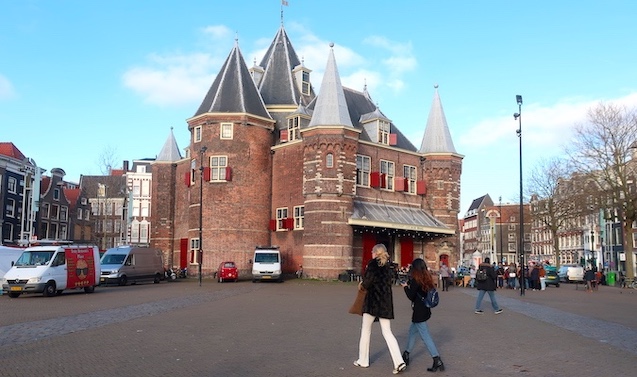
The Waag
The Waag in Amsterdam on Nieuwmarkt Square
Jerzy Gawronksi – city archeologist:
DOWNLOAD AMSTERDAM APP‘The history of De Waag started when the small city of Amsterdam needed to expand in eastern direction. It looks like a small castle, but de Waag used to be a city gate. In medieval times, it used to be a wooden structure.’
The Waag | 1466

The Waag was formerly known as the St. Anthony’s Gate. It’s the oldest non-religious building in Amsterdam. The gate is first referred to in a deed in 1466. However, it is quite possible that it is even older. The outer canal, the current Geldersekade and Kloveniersburgwal, along which the gate was built, was dug during the 1425 expansion of the city.

Made by Frisius, S., Visscher, Claes Jansz (1587-1652) around the year 1600.
The fitteenth-century St Anthony’s Gate had a defensive function. It was a simple gate with walls that were nearly two metres thick and had four towers on the city side were narrow and low; the two broad towers on the canal side had battlements. This oldest part of the city gate is called the main gate.
Addition of the front gate | 1488
The tower on the corner of the Zeedijk and the Geldersekade (The Masons Tower) has a stone tablet that memorializes the “laying of the first stone” in 1488. Contrary to what was long believed, this most likely concerns the expansion of the main gate through the addition of the so-called front gate.
In order to do this, the water in the canals was covered over with a brick arch. This culvert was known as the Bijleveld sluice. Small boats could thus sail through the front gate to the other side of the city canal. The front gate consisted of a walled courtyard above the sluice, with two towers on the corners.
City wall demolished | 1600
At the end of the sixteenth century, Amsterdam underwent two urban expansions. A new defensive work was also constructed. Because of this old outer canal became a normal city canal and St. Anthony’s Gate lost its function. This also applied to the city wall, of which St Anthony’s Gate was part. The city wall was demolished around 1600 and St Anthony’s Gate became free-standing.
Nieuwmarkt Construction | 1611 – 1617
Part of the city canal in front of and on both sides of St Anthony’s Gate was covered over. The water was thus not filled in: rather, a square was built on top of it, forming St Anthony’s Market. This is the current Nieuwmarkt, where of course markets could be held.
Conversion to weigh house | 1617-1618
The former city gate was given a new purpose. The conversion to weigh house followed between 1617 and 1618 in order to relieve the pressure on the Old Waag on Dam square. The inner courtyard was made higher and covered over windows were added, as well as large double doors with overhangs above them.
Merchants had to have all goods over fifty pounds weighed at the Waag. They paid weighing fees for this, the proceeds of which went to city funds. All sort of goods, from iron and lead to beer and hides, were weighed and inspected. These also included artillery and anchors because of nearby shipyards. The anchors were hoisted up on a tall mast above the square, after which they were let down. If they survived the fall, they were approved and marked.
Housing of the guilds | 1617 – 1618
During the conversion to weigh house, the top floor of the former city gate was prepared to house the town militia and a number of guilds. The towers gave access to the guild rooms and the guardroom of the militia. The names of the towers still reflect this: St. Luke’s Tower (painter’s guild), Mason’s Tower (mason’s guild), Militia’s Tower (militia), Theatrum Anatomicum Tower (surgeon’s guild), Clog Maker’s Tower, St. Eloy’s Tower (blacksmith’s guild).
The traces left by the mason’s guild can rightly be called skillful. The master craftsmen who were producing their so-called masterpieces built alcoves, mouldings, blind arches and extra-ordinary columns: each one a testimony to great craftsmanship.

The Nieuwmarkt with the Waag between 1659 and 1662. Seen from the Geldersekade.
Anatomic theatre in Amsterdam | 1691
In 1690-1691, a large, dome-shaped space was built in the middle of the Waag, crowned with a middle tower. This became the Theatrum Anatomicum, where professors of surgeon’s guild taught theory classes. The hall was decorated with a collection of sections, skeletons and stuffed animals.

Amsterdam, Nieuwmarkt, 1756. Drawing by Jan de Beijer.
View from the Sint Antoniesbreestraat on the Nieuwmarkt with the Waag in the middle. In the left foreground the corner of the building Nieuwmarkt 27, in the background the houses Nieuwmarkt 24 to 16, the Bloedstraat, Nieuwmarkt 14 to 6 and the entrance to the Monnikenstraat. Left behind the houses the tower of the Oude Kerk. On the right in the background the Geldersekade with the Schreierstoren in the distance.

Amsterdam, Nieuwmarkt, 1757. The Bloedstraat is located on the right side.
A few times per year an anatomical lesson was given by the so-called praelector anatomiae. In the wintry cold, during the course of a few days the body of a criminal condemned to death would be anatomized. These lessons were open to the public at a charge and were in the habit of having their anatomical lessons immortalized. In the guild room in the Waag, the painted anatomy lessons hung side by side with the group portraits of senior officers. Anatomical education was given in the Waag until 1869.
Execution Site | 1812
Under King Louis Bonaparte, the Nieuwmarkt (New Market) was designated as an execution site.
The Nieuwmarkt seen from the south with in the middle The Waag with the scaffold and the guillotine. In the background spectators, who are kept at a distance on horseback by the guard. This is the first and only time that the death penalty was carried out by guillotine in Amsterdam. The executed were poison mixer Hester Rebekka Nepping, her lover Gerrit Verkerk and housemaid Adriana van Rijswijk.

The Nieuwmarkt with the Sint Antonieswaag, during the execution of the poison mixer Hester Rebecca Nepping and her accomplices Adriana van Rijswijk and Gerrit Verkerk on June 15, 1812.
No longer a weigh house | 1819
View of Amsterdam’s Dam Square in the second half of the 18th century, seen on the Town Hall, the Nieuwe Kerk and The Waag before its renovation in 1775. The clothing of the figures corresponds well to the year of publication, 1814, and is therefore not the same to the topographical situation shown.
In 1819, a chest of indigo was the last item to be weighed in St. Anthony’s weigh house. The Waag was no longer to be a weigh house. A number of important changes had already been made during the period of French rule in the Netherlands. The militia and the guilds, for instance, were abolished at the end of the eighteenth century.

Nieuwmarkt Square with The Waag in the background between 1867 and 1883.
Throughout the nineteenth century The Waag had different tenants, including the city fencing masters, the cholera commission and a furniture manufacturer. From 1874 to 1888 The Waag even operated as a fire station.
After that the City Archives were housed in it until 1914.

Amsterdam, 1916. Vintage market on Nieuwmarkt Square.
The Waag As A Museum | 1926

Amsterdam, Nieuwmarkt, 1925 (source: Stadsarchief Amsterdam)
The Waag began to function as a museum in 1926 when the Amsterdam Historical Museum was accommodated there. In 1932 the Jewish Historical Museum moved into one of the tower rooms.
In 1943, during the Second World War, the museum was forced to close and the museum pieces were taken away to Germany. They were found after WWII, and the museum opened in 1955 on the top floor of the Waag.

Amsterdam, 9 July 1950. The Waag and Nieuwmarkt from above.
In 1974, the Amsterdam Historical Museum moved to another building, and in 1987 the Jewish Historical Museum followed suit. Another new chapter began for the Waag; one of vacancy, a number of failed initiatives for a new purpose, and renovations.
The Waag Today | > 1996

The Waag during the summer of 1998. Source: Stadsarchief Amsterdam/ Alberts, Martin)
Since 1996, after the restoration of the building, The Waag Society, Institute for Art, Science and Technology has taken possesion of the top floors of The Waag.
The Waag Restaurant Amsterdam
Restaurant Cafe in de Waag occupies the ground floor. We would definitely recommend to go to this restaurant. They offer great food, delicious coffee, tasteful Dutch beers and great wines. All reasonable priced. Enjoy your lunch or dinner while sitting in the oldest non-religious building of Amsterdam.
Recent research has shown that the building is subsiding unevenly, which could potentially tear The Waag apart. In fact, in the Masons Tower, this formation of cracks has already begun. The current restoration of the foundation was therefore unavoidable. It will provide the age-old, monumental and striking The Waag with a new future.

ALSO READ:
Amsterdam Red Light District History
35 Fun Things To Do In Amsterdam








